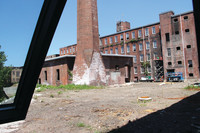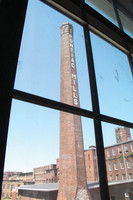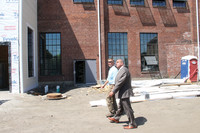By JOHN HOWELL -- It's not difficult to imagine a new life for the sprawling Pontiac Mills any more. Walls now divide the open floors where textile machines once hummed and immigrant workers, first from Sweden and later Ireland, put in 12-hour days to...
This item is available in full to subscribers.
We have recently launched a new and improved website. To continue reading, you will need to either log into your subscriber account, or purchase a new subscription.
If you are a current print subscriber, you can set up a free website account by clicking here.
Otherwise, click here to view your options for subscribing.
Please log in to continue |
|





It’s not difficult to imagine a new life for the sprawling Pontiac Mills any more. Walls now divide the open floors where textile machines once hummed and immigrant workers, first from Sweden and later Ireland, put in 12-hour days to produce cloth under the name of “Fruit of the Loom.”
“I could be right here,” said Susan Baker from the mayor’s office, after walking through what will become a single bed apartment overlooking Pontiac Village with Warwick Mall as a backdrop. Maybe Baker was kidding, but it’s easy to imagine a trendy apartment with lots of open space and light all within a short drive to shopping, Route 95 or 295, commuter rail service and Green Airport.
Baker was among an entourage from the city, including Mayor Joseph Solomon, who were given a tour of the mill complex Tuesday morning by developer Larry Silverstein, president of the Baltimore-based Union Box Company and Project Manager Michael Harrington.
Phase 1 that includes 72 apartments is to be completed in two months. Even a bit sooner – before Labor Day – the owners of the Apponaug Brewing Co. plan to be up and running.
Silverstein said studio apartments would rent for $1,200 and two bedroom units going for $2,200. He said the units are being advertised and interest is high. He expects a mix of tenants from elderly couples looking to downsize to young professionals as well as some corporate financed rentals. When fully built out, the mill will have 137 residential units and 100,000 square feet of commercial space.
The mill complex is extensive, composed of more than 20 buildings when Silverstein took it on. Some buildings have been leveled and, when completed, Silverstein said it would comprise 15 buildings. Some are tiny, like the free-standing paymaster’s building, which makes for great management offices. Others, like a garage on the banks of the Pawtuxet River, could make for great space for a kayak and canoe rental operation, suggests Harrington.
Signs of the transformation are at every turn. Looking down from the upper floor of the mill building facing Knight Street, new roofs contrast starkly with the decaying shingling and façades of other buildings. Grounds have been cleared of rubble in some areas while in others it is piled under a cover of weeds.
Silverstein said no “treasurers” such as ancient mill equipment, or a forgotten safe, were discovered. Everything had been well picked over since the mill closed and an auction was held in the early 1970s. Parts of the complex revived to take on a new life as retail operations for a time. At one point, when federal funding for low-income housing was abundant, the building bordering Knight Street was considered a candidate as a housing complex. The late Rev. Howard Olsen, chairman of the Warwick Housing Authority, vigorously opposed the idea, saying it would have been a ghetto. He favored a scattered housing plan that the city adopted.
The southernmost section of the mill on Route 5 was torn down with the 163-room NYLO Hotel built to conform with the style of the mill, making its debut in 2008. It was forced to close following the flood of 2010 that devastated Pawtuxet River neighborhoods and flooded Warwick Mall. The hotel reopened a year later.
Asked about the dangers of flooding, Silverstein said some river walls on the property have been rebuilt, but a true solution would be a lowering of the dam up river.
Silverstein said a lot of rotten wood and decayed bricks that came out of the mill dates back to the mid-1850s and are listed on the National Register of Historic Places.
“We spent millions cleaning it up and millions to bring it back,” said Silverstein.
The project, comprised of 250,000 square feet, is to be completed in two phases, with the second phase being completed next summer. Silverstein pegged the overall cost of the project at $35 million, which he said would not have been possible without federal and state historic tax credits, Rebuild Rhode Island tax credits and the city tax stabilization act (TSA) that phases in the improved valuation of property for taxation purposes over 10 years.
“This is a great example of a private/public partnership,” said Mayor Solomon. The people and businesses the development will bring into the city excite him.
Harrington estimated anywhere from 50 to 200 people from 20 contracting firms have been working on the site for the past year.
“We have just got to put it back together again, that’s what we have to do,” he said.
Working with the Pontiac Village Association, Luke Murray, special projects coordinator for the planning department, said the city has applied for a $300,000 Rhode Island Commerce Corp Main Street Rhode Island Streetscape Improvement Fund grant. If approved, and paired with Community Development Block Grant funds earmarked for Pontiac and city funding, $450,000 would be made available for Knight Street improvements, including sidewalks and the infrastructure for future lighting.
A third phase of reconstruction involving the construction of a new building to house an additional 50 rental apartments is under consideration, Harrington said.
1 comment on this item Please log in to comment by clicking here
TheSkipper
Yeah, I'll get an apartment there when they show me the decontamination report for the almost 150 years of toxic waste of chemicals that were used in that mill. The solvents, dyes, acids, Lyes, and bleach that's now in the wooden beams,brick,and mortar. Not to mention the Phosphates, Arsenic, cyanide, oils, and cleaning fluids in the ground of that site.
Same thing goes for ANY former millworks.
Thursday, July 12, 2018 Report this